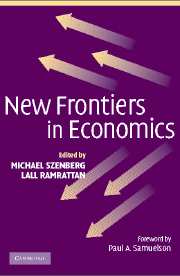Book contents
- Frontmatter
- Contents
- List of Contributors
- Foreword by Paul A. Samuelson
- Preface
- Acknowledgments
- Introduction
- PART I INFORMATIONAL BEHAVIORAL ECONOMICS AND FINANCE
- 1 Information and the Change in the Paradigm in Economics
- 2 Behavioral Economics
- 3 Experiments with Financial Markets: Implications for Asset Pricing Theory
- 4 Two Puzzles of Asset Pricing and Their Implications for Investors
- PART II MACROECONOMICS AND PUBLIC POLICIES
- PART III INTERNATIONAL TRADE AND DEVELOPMENT
- PART IV CONTRACTS, LAW, AND GAMING
- Author Index
- Subject Index
- References
2 - Behavioral Economics
Published online by Cambridge University Press: 06 July 2010
- Frontmatter
- Contents
- List of Contributors
- Foreword by Paul A. Samuelson
- Preface
- Acknowledgments
- Introduction
- PART I INFORMATIONAL BEHAVIORAL ECONOMICS AND FINANCE
- 1 Information and the Change in the Paradigm in Economics
- 2 Behavioral Economics
- 3 Experiments with Financial Markets: Implications for Asset Pricing Theory
- 4 Two Puzzles of Asset Pricing and Their Implications for Investors
- PART II MACROECONOMICS AND PUBLIC POLICIES
- PART III INTERNATIONAL TRADE AND DEVELOPMENT
- PART IV CONTRACTS, LAW, AND GAMING
- Author Index
- Subject Index
- References
Summary
INTRODUCTION
The formal neoclassical paradigm that has dominated economics for decades draws out the implications of a narrow conception of human nature – that we are entirely rational, time-consistent pursuers of our material self-interest. Although there have always been economists who have called for greater realism, only recently has the more narrow conception clearly begun to lose its grip within mainstream economics.
In the last twenty years, more and more economists have attempted to integrate findings from psychology and other fields into economics, using experiments, surveys, and more traditional methods to identify some basic patterns of human preferences, cognition, and behavior that have been traditionally ignored by economists. With a boost from such innovators as Thomas Schelling and George Akerlof, economists have begun to accept that there is merit to exploring such alternatives, while psychologists Daniel Kahneman and Amos Tversky and economist Richard Thaler have been articulating some core psychological principles that economists should pay attention to. Many of the principles proposed by these and other researchers that were perceived ten years ago as ill-conceived, implausible, or unusable by economists are now far more widely accepted. Today, many young researchers have begun to pursue research in behavioral economics; increasingly, they are being hired by top economics departments and published in top economics journals.
This essay reviews some of the psychological principles that have been emphasized in this line of research, which has come to be labeled behavioral economics.
- Type
- Chapter
- Information
- New Frontiers in Economics , pp. 68 - 102Publisher: Cambridge University PressPrint publication year: 2004
References
- 6
- Cited by



